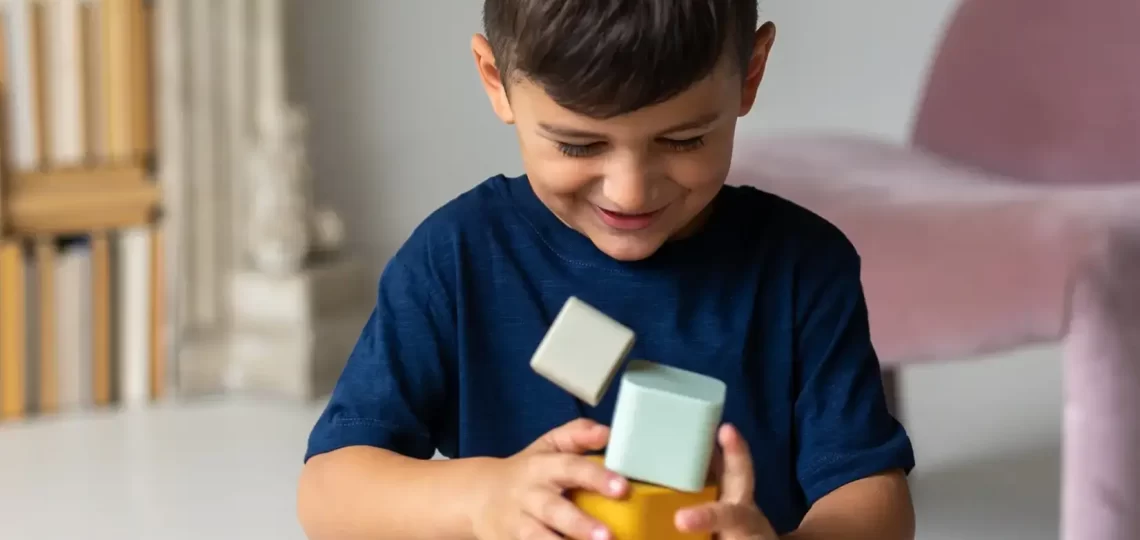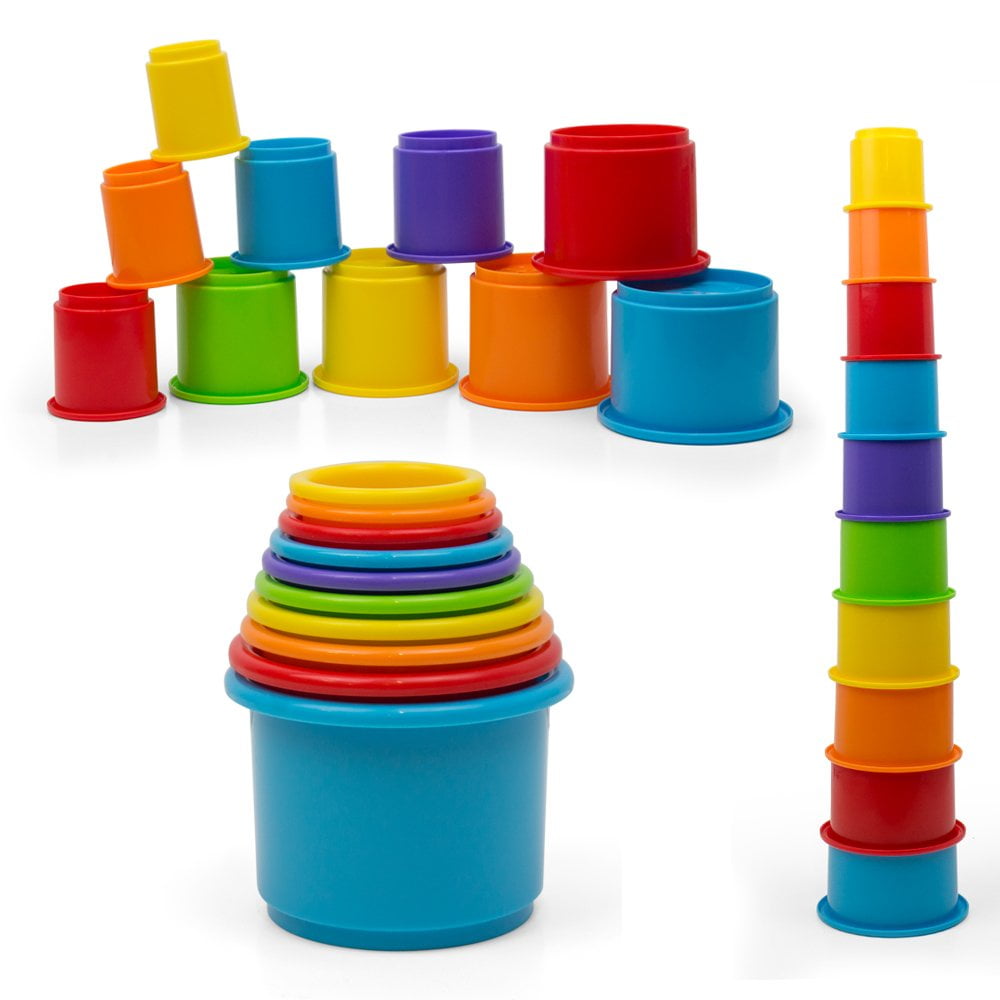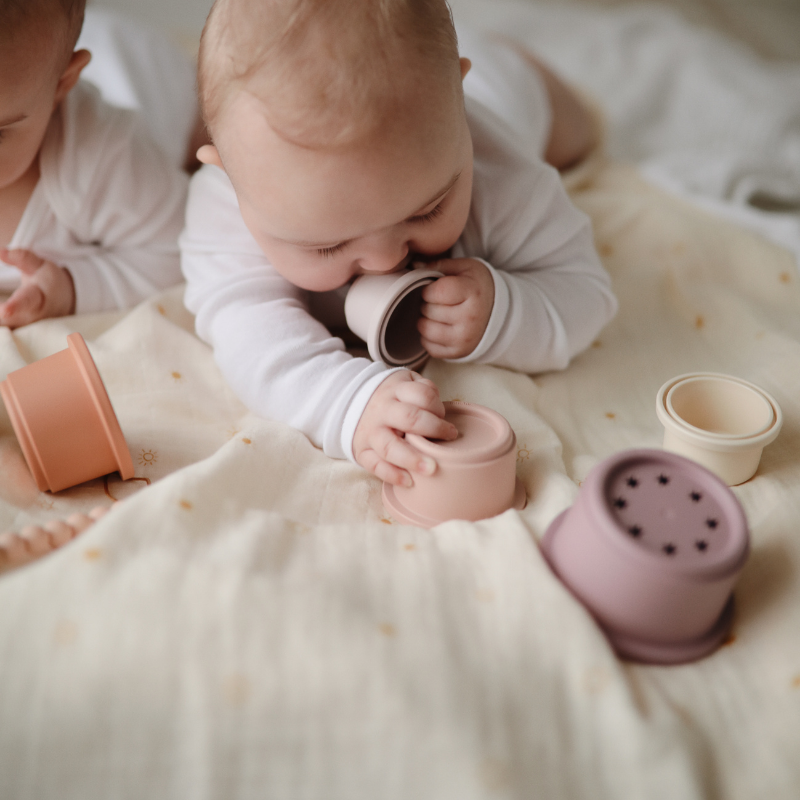
Stacking Cup Toy: Developmental Benefits for Toddlers
The Importance of Play in Toddler Development
The early years of a child’s life are crucial for development. During this time, play acts as more than just a way for toddlers to pass time; it is essential for their overall growth. Through play, toddlers can explore the world around them and learn new skills. A stacking cup toy is one such plaything that offers a plethora of developmental benefits.
While engaging with a stacking cup toy, toddlers are not just stacking objects aimlessly. They are experimenting with cause and effect, improving their hand-eye coordination, and developing problem-solving skills. Playtime with these toys can also be a social activity, encouraging toddlers to interact with others, share, and take turns.
Moreover, play sparks toddlers’ imaginations, a critical aspect of cognitive development. As they build towers or nest cups, they are also building the foundations for creative thinking and innovation. The significance of these moments cannot be overemphasized; they are fundamental stepping stones in their journey to understanding the world.
Another key aspect of play, particularly with a stacking cup toy, is the development of fine motor skills. The precision needed to stack or nest the cups accurately aids in strengthening the small muscles in a child’s hands and fingers.
In summary, play, especially with toys like stacking cups, is a vital component to a toddler’s learning and development. It promotes physical, cognitive, and social skills that form the basis of future learning. Parents and caregivers should encourage play with these toys to help their toddlers reach their developmental milestones.
What is a Stacking Cup Toy?
A stacking cup toy is a set of cups that toddlers can stack or nest. These toys come in various colors and sizes, adding to their appeal for young children. Typically made from durable materials like plastic, they are safe for toddlers to play with. Each cup has a different diameter allowing the cups to fit one into another. The simple design of stacking cups is deceiving; the potential for learning and skill development is immense.
Toddlers often begin playing with stacking cups by trying to fit them together or onto each other. This task, although it seems basic, is effective in challenging the child’s cognitive and physical abilities. Most importantly, a stacking cup toy is versatile. Besides stacking, children can use them in pretend play, they can sort them by color and size, and even use them in water or sand play.
The beauty of a stacking cup toy lies in its simplicity. There is no need for batteries, no complex instructions, just straightforward, imaginative play that aligns with a toddler’s natural curiosity and desire to explore. In essence, these toys offer a hands-on experience for children to learn about their environment and the physical world in an enjoyable and engaging way.
Key Developmental Benefits of Stacking Cup Toys
Stacking cup toys offer multiple developmental benefits for toddlers. Each stacking action improves crucial skills that foster their growth. Here are key developmental advantages provided by these toys:
- Cognitive Development: They challenge the toddler’s brain, helping them understand concepts such as order, size, and spatial awareness. These toys stimulate the child’s thinking process as they determine how to stack the cups effectively.
- Enhanced Problem-Solving Skills: As children try to stack cups, they learn to solve problems. If a cup does not fit, they figure out they need a different piece. This skill is vital throughout life.
- Hand-Eye Coordination: Correctly stacking the cups requires toddlers to align their hands with their visual perception. It enhances their coordination. Precise movements refine these skills further.
- Patience and Persistence: Stacking can be challenging. Toddlers learn to be patient and persistent as they attempt to stack and restack the cups after collapses.
- Memory Improvement: Remembering which cup goes where enhances a toddler’s memory skills, which is crucial for early learning stages.
- Goal Achievement: Completing their stack gives toddlers a sense of accomplishment. It encourages them to set and fulfill goals, boosting their confidence.
These benefits demonstrate how a simple stacking cup toy can be so valuable in the early developmental stages of a child.
Cognitive Skill Enhancement Through Stacking Play
A stacking cup toy sharpens a toddler’s cognitive skills in remarkable ways. It begins with the understanding of spatial concepts. As toddlers stack cups, they gain an intuitive sense of space and size. They comprehend that smaller cups fit into larger ones, laying the groundwork for spatial reasoning.
The play also involves sequencing, where toddlers learn to arrange cups in a specific order. This skill is pivotal for later abilities in math and science. They develop an early understanding of sequences, which is fundamental to pattern recognition.
Furthermore, stacking play enhances memory. A child remembers the sizes and colors to stack the cups correctly. This boosting of memory lays a critical foundation for future learning.
Problem-solving comes into play when a stack topples. Toddlers must figure out why and how to correct it. This process fosters critical thinking and the ability to troubleshoot – skills that they carry into adulthood.
Lastly, stacking cup play nurtures concentration and focus. Toddlers need to pay close attention to balance the cups and avoid a collapse. Regular play can lead to better attention spans over time.
In summary, stacking cups offer valuable experiences in cognitive development. They teach size and space, sequence, memory, problem-solving, and concentration. These are key skills that prepare toddlers for the academic challenges ahead.
Fine and Gross Motor Skill Development
Stacking cup toys not only enhance cognitively, but also foster both fine and gross motor skills in toddlers. These skills are crucial to the mastery of everyday tasks and overall physical coordination. Here is how stacking cup play aids in motor development:
- Fine Motor Skills: These refer to the ability to use small muscles, particularly in the hands and fingers. Picking up, gripping, and placing the cups into or on top of each other hones precision movements. It requires toddlers to use pinching motions, a skill important for tasks like writing or buttoning clothes.
- Gross Motor Skills: In comparison, gross motor skills involve larger movements and muscle groups. When toddlers reach for cups that are out of their immediate grasp, or adjust their body position to stack higher towers, they engage their arm, leg, and core muscles. Such activities help them manage their balance and body awareness.
The act of repeatedly stacking and unstacking cups also teaches toddlers about control and manipulation of objects. They learn the strength needed to handle objects without causing a tumble. This control is fundamental in later physical activities such as throwing a ball or using playground equipment.
Encouraging toddlers to stack cups at varied paces can simulate different play scenarios, further improving motor abilities. Slow, deliberate stacking fosters dexterity, whereas quick stacking can develop reflexes and speed. Regardless of how they play, stacking cup toys ultimately contribute to a toddler’s ability to coordinate their body effectively—setting the stage for an active, healthy lifestyle.
Color and Size Recognition with Stacking Cups
Stacking cup toys are a fun way to teach toddlers about colors and sizes. While playing, toddlers learn to recognize and differentiate between the various hues. Each cup’s unique color prompts toddlers to match and name them during play. This activity boosts their ability to identify colors, a key step in their visual learning.
In addition to colors, toddlers also learn about sizes through these toys. They discover that larger cups can hold smaller ones. Understanding this concept helps them develop size recognition skills. They begin to grasp the relationship between objects of different sizes, which is an early math skill.
Stacking cups aid in constructing a mental picture of big and small. This skill helps a toddler navigate their wider environment. For instance, they use it when comparing the sizes of toys, food portions, or different animals. Through play, toddlers start categorizing things based on size, a cognitive process that lays a foundation for logical thinking. Playtime with stacking cup toys thus becomes an educational experience. It prepares toddlers for more formal learning in preschool and beyond. When a toddler stacks a small cup onto a larger one, it’s more than play. It’s a lesson in recognizing and sorting the world around them.
Through this simple play activity, toddlers not only enjoy themselves but also develop critical early learning skills. Therefore, it’s important to include a variety of colors and sizes in the stacking cup toys we provide to them. This variety encourages a richer learning experience and fosters an enjoyable way to engage with fundamental concepts.
Social and Emotional Growth Opportunities
Stacking cup toys do more than develop cognitive and motor skills. They also offer vital social and emotional growth opportunities for toddlers. Engaging with these toys during playtime helps toddlers learn essential life skills.
Firstly, Social Interactions are encouraged when toddlers play with stacking cups. Often, this play involves more than one child, prompting them to communicate and collaborate. They learn to take turns and share, which are fundamental aspects of social etiquette.
Next, Emotional Development is enhanced as toddlers face the challenges of stacking. They experience feelings of frustration when the cups topple and joy when they complete the stack. These experiences help toddlers understand and manage their emotions better. Recognizing and coping with frustration or excitement are crucial emotional insights for young children.
Additionally, Empathy Building occurs when toddlers play together. They see other children’s reactions to the same challenges and successes, which develops empathy and understanding. Observing and sharing these emotional responses is essential for emotional intelligence.
Lastly, Confidence grows with each successful stacking experience. As toddlers achieve their simple goals, their self-esteem boosts. This increased confidence can extend into other areas of their social and school life. Believing in their abilities begins with such simple, supportive play environments.
Overall, stacking cup toys not only prepare toddlers for academic learning but also for social settings and emotional challenges in their future.
Choosing the Right Stacking Cup Toy for Your Toddler
Choosing the best stacking cup toy involves several considerations to ensure it benefits your toddler’s development effectively. Here are some tips to help you select the ideal toy:
- Safety First: Always check that the toy is non-toxic and has smooth edges. Ensure all materials used are safe for children.
- Size and Weight: Pick cups that are easy for tiny hands to grasp. They should not be too heavy or too light.
- Colorful and Engaging: Bright colors attract toddlers’ attention and stimulate visual development. Choose a set with a variety of colors.
- Material Durability: Opt for cups made from durable materials like rigid plastic. They should withstand rough play and not break easily.
- Educational Value: Some sets come with numbers or patterns. These can help teach early numeracy or sorting skills.
- Versatility: Look for stacking cups that can be used in different types of play—such as in water, sand, or for general play.
By focusing on these factors, you can find a stacking cup toy that is not only fun but also a valuable tool in your toddler’s developmental journey. Always remember to supervise their play to ensure safety at all times.
Incorporating Stacking Cups into Daily Play Routines
To maximize the benefits stacking cup toys offer, it’s ideal to incorporate them into daily play routines. Here are a few strategies that can help parents and caregivers seamlessly introduce stacking cups into a toddler’s daily activities:
- Schedule Regular Playtimes: Set aside specific times each day dedicated to playing with stacking cups. This consistency helps toddlers look forward to and enjoy this play activity regularly.
- Interactive Play: Join in on the play. Toddlers often mimic adults, so show enthusiasm and creativity as you stack cups with them. This interaction substantially boosts their social and emotional development.
- Incorporate Into Other Activities: Use stacking cups during bath time or at the beach for multifaceted play. They’re perfect for water and sand activities, which adds diversity to their play experience.
- Introduce Challenges: As toddlers get older, introduce little challenges such as timing their stacking or asking them to stack by color or size. Such games can enhance cognitive development and problem-solving skills.
- Encourage Clean-up: Make putting away the cups part of the routine. This teaches responsibility and organization, turning even clean-up time into a developmental opportunity.
By integrating stacking cup toys into everyday play, toddlers can consistently develop important skills while having fun. For parents and caregivers, it offers a fruitful avenue to engage with their children and witness their growth firsthand.


